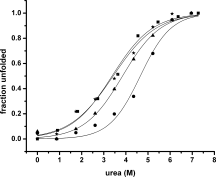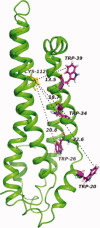Structural differences between apolipoprotein E3 and E4 as measured by (19)F NMR
- PMID: 19904741
- PMCID: PMC2817840
- DOI: 10.1002/pro.283
Structural differences between apolipoprotein E3 and E4 as measured by (19)F NMR
Abstract
The apolipoprotein E family contains three major isoforms (ApoE4, E3, and E2) that are directly involved with lipoprotein metabolism and cholesterol transport. ApoE3 and apoE4 differ in only a single amino acid with an arginine in apoE4 changed to a cysteine at position 112 in apoE3. Yet only apoE4 is recognized as a risk factor for Alzheimer's disease. Here we used (19)F NMR to examine structural differences between apoE4 and apoE3 and the effect of the C-terminal domain on the N-terminal domain. After incorporation of 5-(19)F-tryptophan the 1D (19)F NMR spectra were compared for the N-terminal domain and for the full length proteins. The NMR spectra of the N-terminal region (residues 1-191) are reasonably well resolved while those of the full length wild-type proteins are broad and ill-defined suggesting considerable conformational heterogeneity. At least four of the seven tryptophan residues in the wild type protein appear to be solvent exposed. NMR spectra of the wild-type proteins were compared to apoE containing four mutations in the C-terminal region that gives rise to a monomeric form either of apoE3 under native conditions (Zhang et al., Biochemistry 2007; 46: 10722-10732) or apoE4 in the presence of 1 M urea. For either wild-type or mutant proteins the differences in tryptophan resonances in the N-terminal region of the protein suggest structural differences between apoE3 and apoE4. We conclude that these differences occur both as a consequence of the Arg158Cys mutation and as a consequence of the interaction with the C-terminal domain.
Figures







Similar articles
-
Fluorescence study of domain structure and lipid interaction of human apolipoproteins E3 and E4.Biochim Biophys Acta. 2014 Dec;1841(12):1716-24. doi: 10.1016/j.bbalip.2014.09.019. Biochim Biophys Acta. 2014. PMID: 25281910 Free PMC article.
-
Concerning the structure of apoE.Protein Sci. 2013 Dec;22(12):1820-5. doi: 10.1002/pro.2379. Epub 2013 Oct 19. Protein Sci. 2013. PMID: 24115173 Free PMC article.
-
Conformational analysis of apolipoprotein E3/E4 heteromerization.FEBS J. 2019 May;286(10):1986-1998. doi: 10.1111/febs.14794. Epub 2019 Mar 13. FEBS J. 2019. PMID: 30802357 Free PMC article.
-
Apolipoprotein E: from cardiovascular disease to neurodegenerative disorders.J Mol Med (Berl). 2016 Jul;94(7):739-46. doi: 10.1007/s00109-016-1427-y. Epub 2016 Jun 9. J Mol Med (Berl). 2016. PMID: 27277824 Free PMC article. Review.
-
Apolipoprotein E and oxidative stress in brain with relevance to Alzheimer's disease.Neurobiol Dis. 2020 May;138:104795. doi: 10.1016/j.nbd.2020.104795. Epub 2020 Feb 6. Neurobiol Dis. 2020. PMID: 32036033 Free PMC article. Review.
Cited by
-
Functional insights from biophysical study of TREM2 interactions with apoE and Aβ1-42.Alzheimers Dement. 2020 Oct 8:10.1002/alz.12194. doi: 10.1002/alz.12194. Online ahead of print. Alzheimers Dement. 2020. PMID: 33090700 Free PMC article.
-
Native Mass Spectrometry, Ion Mobility, Electron-Capture Dissociation, and Modeling Provide Structural Information for Gas-Phase Apolipoprotein E Oligomers.J Am Soc Mass Spectrom. 2019 May;30(5):876-885. doi: 10.1007/s13361-019-02148-z. Epub 2019 Mar 18. J Am Soc Mass Spectrom. 2019. PMID: 30887458 Free PMC article.
-
Fluorescence study of domain structure and lipid interaction of human apolipoproteins E3 and E4.Biochim Biophys Acta. 2014 Dec;1841(12):1716-24. doi: 10.1016/j.bbalip.2014.09.019. Biochim Biophys Acta. 2014. PMID: 25281910 Free PMC article.
-
Mass spectrometry-based protein footprinting characterizes the structures of oligomeric apolipoprotein E2, E3, and E4.Biochemistry. 2011 Sep 27;50(38):8117-26. doi: 10.1021/bi200911c. Epub 2011 Sep 2. Biochemistry. 2011. PMID: 21848287 Free PMC article.
-
A Fluorescence Correlation Spectrometer for Measurements in Cuvettes.Biophys J. 2018 Aug 7;115(3):455-466. doi: 10.1016/j.bpj.2018.05.038. Biophys J. 2018. PMID: 30089243 Free PMC article.
References
-
- Aggerbeck LP, Wetterau JR, Weisgraber KH, Wu CS, Lindgren FT. Human apolipoprotein E3 in aqueous solution. II. Properties of the amino- and carboxyl-terminal domains. J Biol Chem. 1988;263:6249–6258. - PubMed
-
- Hatters DM, Peters-Libeu CA, Weisgraber KH. Apolipoprotein E structure: insights into function. Trends Biochem Sci. 2006;31:445–454. - PubMed
-
- Perugini MA, Schuck P, Howlett GJ. Self-association of human apolipoprotein E3 and E4 in the presence and absence of phospholipid. J Biol Chem. 2000;275:36758–36765. - PubMed
-
- Yokoyama S, Kawai Y, Tajima S, Yamamoto A. Behavior of human apolipoprotein E in aqueous solutions and at interfaces. J Biol Chem. 1985;260:16375–16382. - PubMed
Publication types
MeSH terms
Substances
Grants and funding
LinkOut - more resources
Full Text Sources
Miscellaneous

